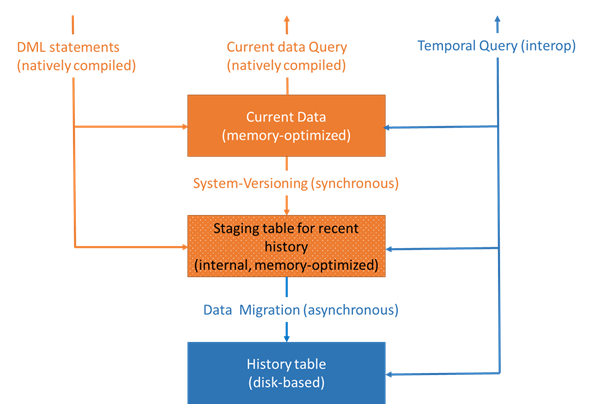System-versioned temporal tables are also supported for memory-optimized tables. You can assign or let SQL Server create a history table for your memory-optimized table. The history table must be a disk table, but this is exactly what you want; frequently used (hot) data remains in memory, while cold data can reside in disk tables. By taking this approach, you can use all the benefits provided by memory-optimized tables (high transactional throughput, lock-free concurrency), save their historical data on disk-based tables, and leave memory for active datasets only. The following figure shows the architecture of system-versioned memory-optimized tables. It is taken from the Books Online page at https://msdn.microsoft.com/en-us/library/mt590207.aspx:

As you can see, system-versioned temporal tables are implemented with three tables:
- Current table is a memory-optimized table and all native compiled operations are supported
- Recent history table is an internal memory-optimized table that handles changes in the current table synchronously and enables DMLs to be executed from natively compiled code
- History table is a disk table that contains changes in the current table and manages them asynchronously
Historical data is a union of data in the recent history and history tables. A history row is either in the staging memory table or in the disk table; it cannot be in both tables. The following code example creates a new memory-optimized temporal table:
USE WideWorldImporters; CREATE TABLE dbo.Product ( ProductId INT NOT NULL PRIMARY KEY NONCLUSTERED, ProductName NVARCHAR(50) NOT NULL, Price MONEY NOT NULL, ValidFrom DATETIME2 GENERATED ALWAYS AS ROW START HIDDEN NOT NULL, ValidTo DATETIME2 GENERATED ALWAYS AS ROW END HIDDEN NOT NULL, PERIOD FOR SYSTEM_TIME (ValidFrom, ValidTo) ) WITH (MEMORY_OPTIMIZED = ON, DURABILITY = SCHEMA_AND_DATA, SYSTEM_VERSIONING = ON (HISTORY_TABLE = dbo.ProductHistory));
After the execution of this query, you will see that the history table is a memory-optimized table.
SELECT CONCAT(SCHEMA_NAME(schema_id),'.', name) AS table_name, is_memory_optimized, temporal_type_desc FROM sys.tables WHERE name IN ('Product', 'ProductHistory');
The result of the preceding query is as follows:
table_name is_memory_optimized temporal_type_desc ----------------- ------------------- ------------------------------ dbo.Product 1 SYSTEM_VERSIONED_TEMPORAL_TABLE dbo.ProductHistory 0 HISTORY_TABLE
As mentioned earlier, SQL Server creates a third table automatically: an internal memory-optimized table. Here is the code that you can use to find its name and properties:
SELECT CONCAT(SCHEMA_NAME(schema_id),'.', name) AS table_name, internal_type_desc FROM sys.internal_tables WHERE name = CONCAT('memory_optimized_history_table_', OBJECT_ID('dbo.Product'));
And here is its output:

Only durable, memory-optimized tables can be system-versioned temporal tables, and history tables must be disk based. Since all current rows are in memory, you can use natively compiled modules to access this data. Use the following code to create a natively compiled stored procedure that handles the inserting and updating of products:
CREATE OR ALTER PROCEDURE dbo.SaveProduct
(
@ProductId INT,
@ProductName NVARCHAR(50),
@Price MONEY
)
WITH NATIVE_COMPILATION, SCHEMABINDING, EXECUTE AS OWNER
AS
BEGIN ATOMIC WITH
(TRANSACTION ISOLATION LEVEL = SNAPSHOT, LANGUAGE = N'English')
UPDATE dbo.Product SET ProductName = @ProductName, Price = @Price WHERE ProductId = @ProductId
IF @@ROWCOUNT = 0
INSERT INTO dbo.Product(ProductId,ProductName,Price) VALUES (@ProductId, @ProductName, @Price);
END
GO
Now you can, for instance, add two rows and update one of them by using the previous procedure:
EXEC dbo.SaveProduct 1, N'Home Jersey Benfica', 89.95; EXEC dbo.SaveProduct 2, N'Away Jersey Juventus', 89.95; EXEC dbo.SaveProduct 1, N'Home Jersey Benfica', 79.95;
Under the hood, everything works perfectly; both the current and history tables are updated. Here are the resulting datasets in the current and historical table:

The querying of historical data is effectively under the SNAPSHOT isolation level and always returns a union between the in-memory staging buffer and the disk-based table without duplicates. Since temporal queries (queries that use the FOR SYSTEM_TIME clause) touch memory-optimized and disk tables, they can be used only in interop mode; it is not possible to use them in natively compiled procedures.
Data from the internal memory-optimized staging table is regularly moved to the disk-based history table by the asynchronous data flush task. This data flush mechanism has the goal of keeping the internal memory buffers at less than 10% of the memory consumption of their parent objects.
When you add system-versioning to an existing non-temporal table, expect a performance impact on update and delete operations because the history table is updated automatically. Every update and delete is recorded in the internal memory-optimized history table, so you may experience unexpected memory consumption if your workload uses those two operations.
